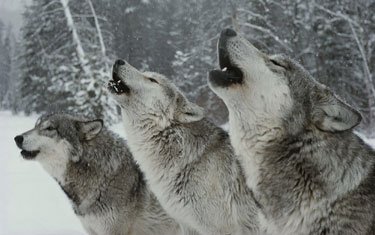“Listen to Them, the Children of the Night. What Music They Make!”
Canids, Language, Wolves
Holly Root-Gutteridge studies wolf dialects.
After hundreds of hours listening to thousands of wolves for my PhD, the difference between howls was obvious. The voice of a Russian wolf was nothing like that of a Canadian, and a jackal was so utterly different again that it was like listening to Farsi and French. I believed that there must be geographic and subspecies distinctions. Other researchers had made this proposition before, but no one had put together a large enough collection of howls to test it properly. …
Studies since the 1960s have shown that the howls that have haunted our dreams for centuries can tell us a lot about the particular wolf vocalising. Like humans, each wolf has its own voice. Each pack also shares howl similarities, making different families sound distinct from each other (wolves respond more favourably to familiar howls). This much we knew. What we didn’t know was whether the differences seen between packs were true of subspecies or of species, and if an Indian wolf howl would be distinct from a Canadian one.
More questions follow. If howls from different subspecies are different, do the howls convey the same message? Is there a shared culture of howl-meanings, where an aggressive howl from a European wolf means the same thing as an aggressive howl of a Himalayan? And can a coyote differentiate between a red wolf howling with aggressive intent and one advertising the desire to mate? Even without grammar or syntax, howls can convey intent, and if the shape of the howl changes enough while the intent remains constant, the foundations of distinctive culture can begin to appear. … Our canine voice collection represented was one of the most comprehensive ever.
We compared howls across 13 different subspecies and species of coyotes, dogs, wolves and jackals (collectively known as canids).
We then stretched all the howls to the same length, using a process called dynamic time warping, to compare the changes in the tune without including the tempo it was played at. We found that each species had its own favourite howl shape, a preferred set of changes to their howls to raise and drop the pitch, but that they also used howl shapes preferred by other species, and varied the shapes as they pleased. The species were like music bands with preferred styles of playing, whether riff-filled like jazz or the pure tones of classical, but were flexible in what they actually played at any given time. So while they had a favourite style, the tune itself varied.
Like musicians, the wolves were influenced by their forebears in the genre, and species shared traits with other canids that were closer to them geographically and genetically. An Eastern grey wolf, recorded in the US, sounded more like a North Carolinian red wolf than a European wolf, and an African jackal sounded quite different again. Small and delicate compared with their cousins the European wolves, golden jackals have high, rising howls, running up and down the scales in bravura performances of control and speed, but with less variation in overall shape, whereas the European wolves used a slower style of deep and steady long notes ending in falls that seem to drift away into the night. New Guinea singing dogs earned their names with a large vocal repertoire and a wide selection of howl shapes. While sometimes the different species achieved crossovers to other shapes, most had a style that dominated their repertoires.
Read the whole thing.




